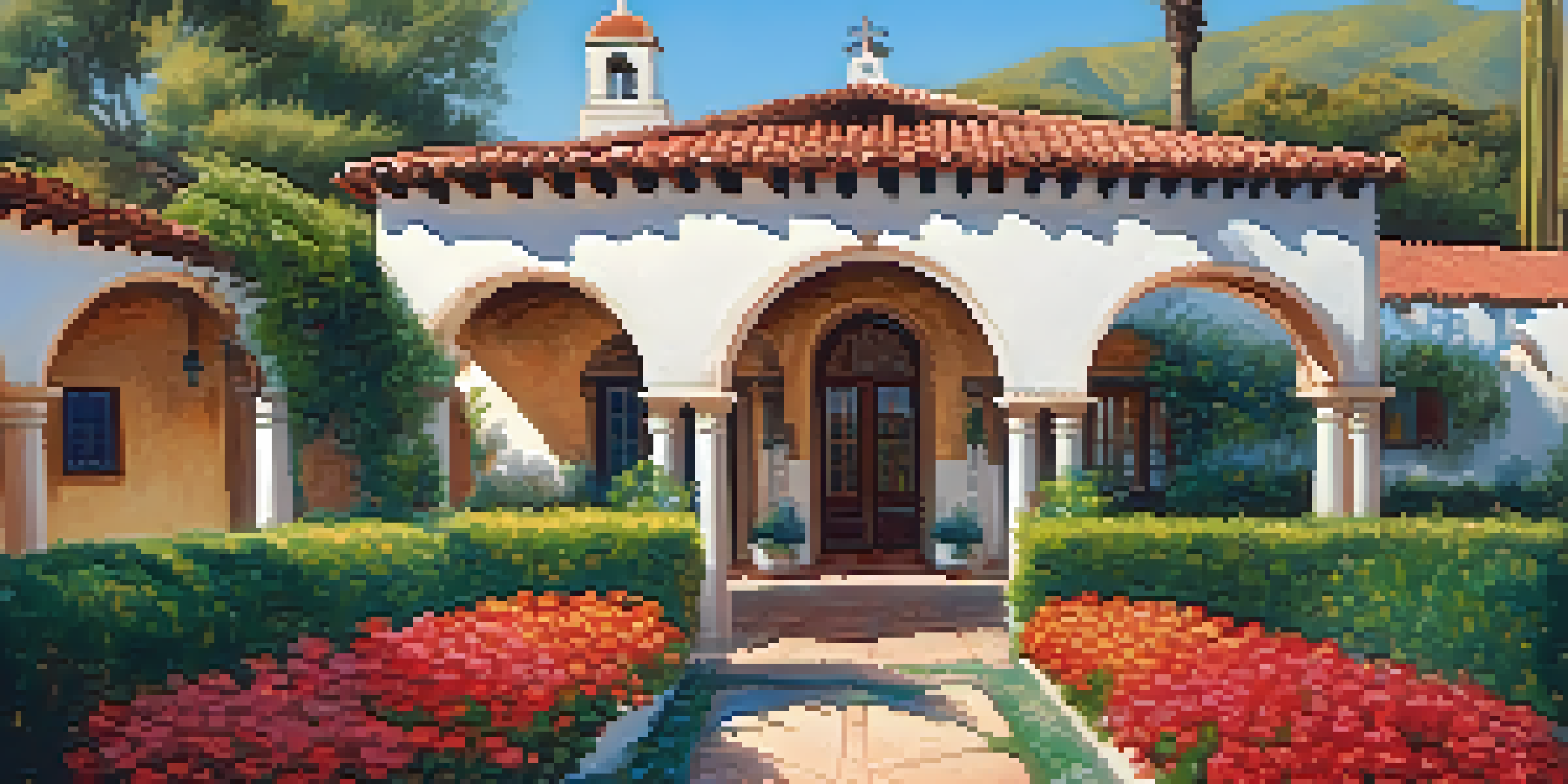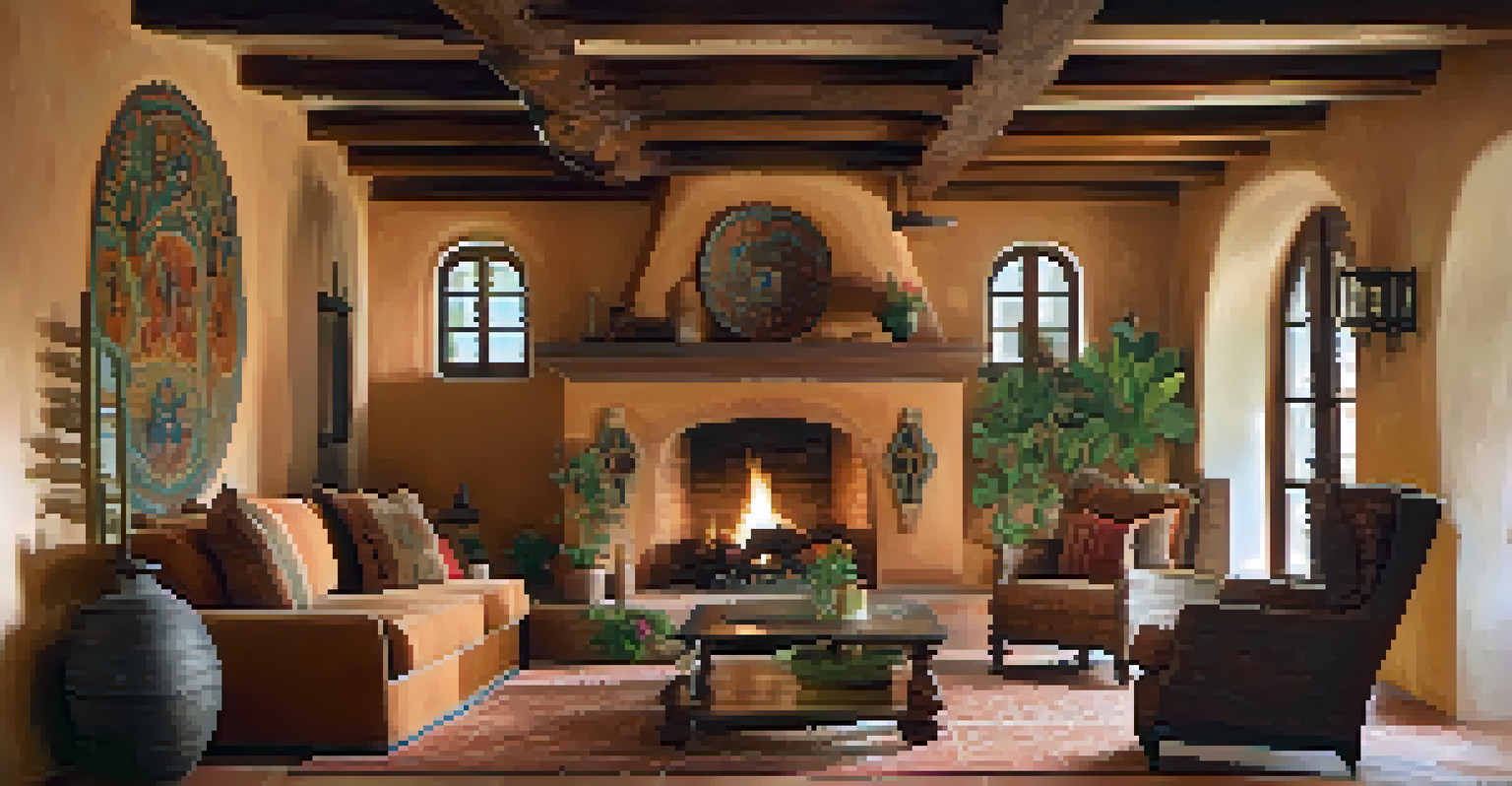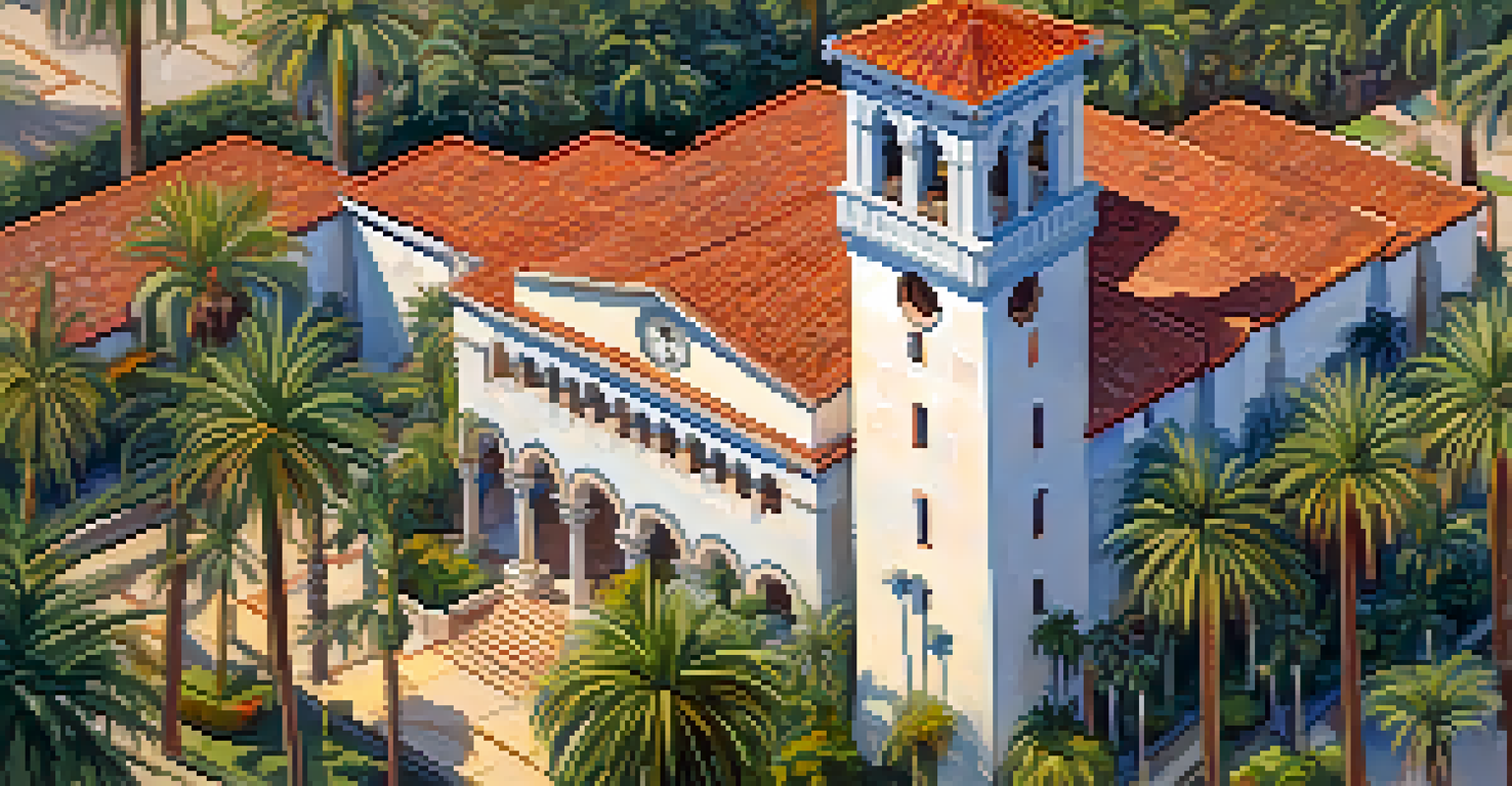Spanish Colonial Architecture: A Glimpse into California's Past

Understanding Spanish Colonial Architecture in California
Spanish Colonial architecture is a style that emerged during the Spanish colonization of the Americas. It blends indigenous elements with European influences, creating a unique aesthetic that reflects California's rich history. This architectural style is characterized by its use of stucco walls, red-tiled roofs, and intricate wrought-iron details, which together evoke a sense of old-world charm and elegance.
Architecture is the learned game, correct and magnificent, of forms assembled in the light.
The California mission system, established in the late 18th century, played a pivotal role in shaping this architectural style. Each mission was designed to serve both as a place of worship and a center for community life, showcasing the blend of functionality and beauty. These missions, many of which still stand today, serve as a testament to the enduring legacy of Spanish colonial architecture in the region.
In essence, Spanish Colonial architecture is more than just a visual style; it's a reflection of the cultural confluence that defines California. It tells the story of the people who built it, their values, and their interactions with the land and each other. Understanding this architecture allows us to appreciate the deeper narratives of California's past.
Key Features of Spanish Colonial Architecture
One of the most striking features of Spanish Colonial architecture is the use of adobe, a natural building material made from clay and straw. This material is not only abundant in California but also provides excellent insulation, making it ideal for the region's climate. The thick walls created from adobe give these buildings a sturdy and timeless quality that has helped many structures withstand the test of time.

Another hallmark of this style is the red-tiled roofs, which are often seen in both residential and commercial buildings. These roofs are not just aesthetically pleasing; they serve a practical purpose by reflecting sunlight and keeping interiors cool. The tiles are typically made from clay, giving them their distinctive hue and durability, which further enhances their charm.
Spanish Colonial Style Defined
Spanish Colonial architecture blends indigenous and European elements, showcasing unique features like stucco walls and red-tiled roofs.
Additionally, ornamental details such as arched doorways, wrought-iron balconies, and decorative tiles are prevalent in Spanish Colonial architecture. These elements add character and artistic flair to the buildings, making them visually captivating. The fusion of these features creates a cohesive look that is instantly recognizable and deeply rooted in California's architectural heritage.
The Role of California Missions in Architecture
The California missions, established by Spanish settlers, are perhaps the most iconic examples of Spanish Colonial architecture. Each mission was built to serve as a religious and cultural hub for Spanish settlers and Native Americans alike. The architecture of these missions varied slightly, but many featured a central courtyard, a chapel, and living quarters, all designed to foster community and spiritual growth.
Every building is a product of its time; it reflects the history and culture of the people who create it.
Mission San Diego de Alcalá, the first mission in California, set the tone for future constructions with its simple yet elegant design. As more missions were established, they incorporated local materials and adapted to the unique landscape, resulting in a distinct California flavor within the Spanish Colonial style. This adaptability is part of what makes these missions so significant in the study of architecture.
Today, many of these missions are preserved as historical sites, allowing visitors to experience a piece of California's colonial past. They not only provide insight into the architectural practices of the time but also serve as a reminder of the cultural exchanges that occurred between Spanish settlers and Native Americans. This rich history continues to influence California's architectural identity.
Influence of Spanish Colonial Architecture on Modern Design
Spanish Colonial architecture has had a lasting impact on modern design, particularly in California. Many contemporary homes and buildings incorporate elements of this classic style, such as stucco exteriors and tiled roofs, creating a harmonious blend of old and new. This revival speaks to the enduring appeal of Spanish Colonial aesthetics, as homeowners and architects alike seek to capture its charm.
Moreover, the influence extends beyond residential spaces; commercial buildings, hotels, and even public structures often draw inspiration from Spanish Colonial design. This architectural style promotes a relaxed, inviting atmosphere, making it a popular choice for spaces meant to welcome guests and foster community interaction. The timeless elegance of Spanish Colonial architecture continues to resonate in today's architectural landscape.
Missions: Architectural Icons
The California missions serve as iconic examples of Spanish Colonial architecture, reflecting the cultural exchanges between Spanish settlers and Native Americans.
As we embrace modernity, it's essential to recognize the cultural significance of these design choices. By incorporating Spanish Colonial elements into new constructions, we honor the rich history and diverse influences that have shaped California. This ongoing dialogue between past and present enriches our understanding of architectural evolution and cultural identity.
Preservation Efforts for Spanish Colonial Architecture
Preserving Spanish Colonial architecture is crucial for maintaining California's historical narrative. Many organizations and local governments are dedicated to protecting these architectural treasures from neglect and deterioration. Efforts include restoration projects, educational programs, and community engagement initiatives that emphasize the importance of preserving our heritage.
One notable example is the California Historical Landmarks program, which recognizes and protects significant sites, including Spanish Colonial structures. By designating these buildings as landmarks, we ensure their historical integrity is maintained for future generations. Community involvement in preservation efforts also plays a vital role, as local residents often have a personal connection to these sites.
In addition to governmental efforts, private organizations and nonprofits work tirelessly to conserve and restore these architectural gems. Their commitment not only helps preserve physical structures but also fosters a greater appreciation for the cultural significance of Spanish Colonial architecture. This collective effort ensures that these historical sites continue to tell their stories for years to come.
Exploring Notable Examples of Spanish Colonial Architecture
California is home to numerous notable examples of Spanish Colonial architecture, each with its unique story. One standout is the Mission Santa Barbara, often referred to as the 'Queen of the Missions' due to its stunning beauty and well-preserved structure. With its twin bell towers and vibrant gardens, this mission captures the essence of Spanish Colonial design and serves as an important cultural site.
Another remarkable example is the Old Mission San Juan Capistrano, famous for its iconic Serra Chapel and the swallows that return each year. This mission showcases intricate tile work and beautiful arches that reflect the artistry of Spanish Colonial architecture. Visitors are often enchanted by its serene atmosphere and historical significance, making it a popular destination.
Modern Influence of Tradition
Today's architecture continues to draw inspiration from Spanish Colonial design, promoting a harmonious blend of historical charm and modern functionality.
Beyond missions, structures like the Santa Barbara Courthouse exemplify the grandeur of Spanish Colonial Revival architecture. With its colorful tiles, ornate ceilings, and lush gardens, this courthouse is a beloved landmark that embodies the spirit of the era. Exploring these sites allows us to appreciate the craftsmanship and historical context that define California's architectural landscape.
The Cultural Significance of Spanish Colonial Architecture
Spanish Colonial architecture represents more than just a building style; it embodies the cultural fusion that defines California. The architecture reflects the convergence of Spanish, Native American, and later Mexican influences, creating a rich tapestry of history and identity. This blend is evident in the materials, designs, and even the purposes of the buildings, which often served as community hubs.
The continued appreciation for Spanish Colonial architecture highlights its role in shaping California's cultural landscape. As people visit missions and preserved buildings, they engage with the stories of those who came before them. This connection fosters a sense of pride and awareness of the diverse heritage that contributes to California's identity today.

Ultimately, Spanish Colonial architecture serves as a bridge between past and present, inviting us to explore our roots and understand our collective history. By recognizing its cultural significance, we can ensure that these architectural marvels are celebrated and preserved for generations to come, enriching our understanding of California's dynamic past.